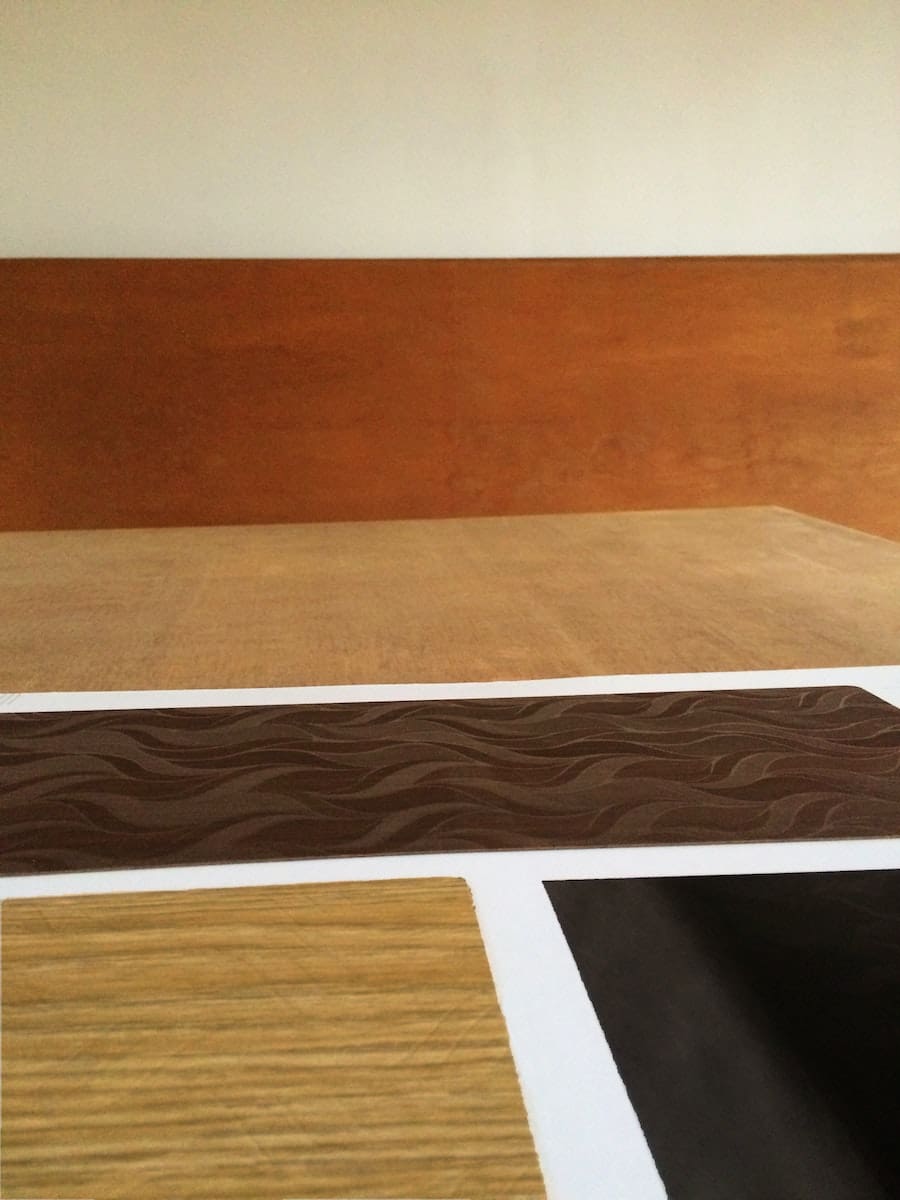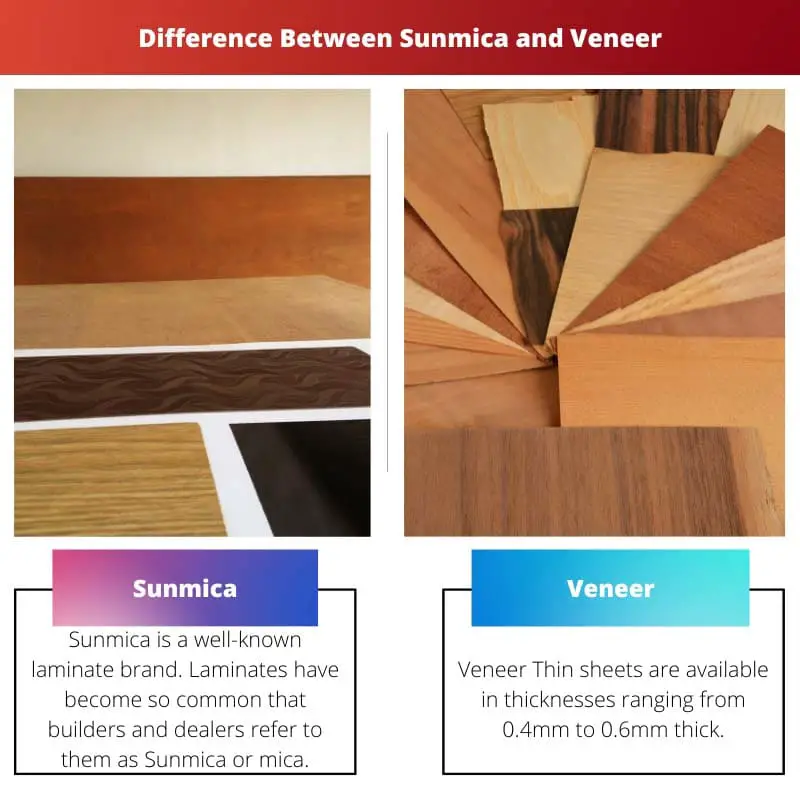A veneer is made consisting of tiny wood slices that are pressed together to form sheets. Tree bark is commonly used to make thin sheets.
Veneer sheets have an attractive appearance, similar to their parent material because they are made of wood. Moreover, Sunmica sheets are made up of paper and plastic by hydraulic press.
Key Takeaways
- Sunmica is a laminate made from layers of paper and resin, while veneer consists of thin slices of natural wood glued onto a substrate.
- Veneer offers a more authentic and luxurious appearance due to the use of real wood, whereas Sunmica provides a more uniform and consistent look.
- Sunmica is more resistant to heat, moisture, and scratches than veneer, making it a more durable and low-maintenance option.
Sunmica vs Veneer
Veneer is more expensive than Sunmica, but it offers a unique, one-of-a-kind look that cannot be replicated by synthetic materials. Although, Sunmica has more durability, low maintenance, and cost-effectiveness than veneer. Also, Sunmica is synthetic, while the veneer is from natural wood.

Sunmica sheets are extremely long-lasting. They’re also scratch-resistant. These sheets can tolerate heat, dampness, tear, and wear to a certain level.
However, precautions should be taken to ensure that they do not spend too much time in wet regions.
Sunmica is available in a variety of price ranges depending on the design utilized and the quality of the laminate sheet used. The price is computed based on the sheets’ per-square-foot area.
Veneer sheets come in a variety of shapes and sizes. People prefer them for interior decoration. Veneer sheet prices vary depending on the quality of the sheets. However, they are cheaper than their rival.
Veneer sheets made of porcelain last around ten years longer than veneer sheets made of composite or plastic. Veneer laminates are available in a wide range of styles and colors.
Comparison Table
| Parameters of Comparison | Sunmica | Veneer |
|---|---|---|
| Price | More expensive | Less expensive |
| Durability | More | Comparatively less except Porcelain |
| Thickness | Comparatively less | Comparatively more |
| Composition | plastic and papers | Wood |
| Properties | Anti-bacterial, anti-fungal | Not antibacterial or anti-fungal |
What is Sunmica?
Sunmica is a well-known laminate brand. Laminates have become so common that builders and dealers refer to them as Sunmica or mica.
However, it’s no different than putting to a color printer and asking for photocopies when you should be looking for photocopies. Because the firm that made the photocopying machine was called Xerox.
Sunmica is a colorful laminate sheet that’s also commonly used to cover wood furniture. Sunmica can be used in every nook and corner of your home since it is so adaptable.
It can be used in a variety of applications, including flooring, ceilings, tabletops, wall panels, and furniture.
Sunmica is an attractive, blemish-free, and long-lasting material. Furthermore, it can withstand wear and tear, moisture, and normal heat up to a certain point.
You must, however, be cautious while subjecting it to water. Because if it isn’t waterproof, it will quickly distort if it is exposed to water for an extended period.

What is Veneer?
Veneer Thin sheets are available in thicknesses ranging from 0.4mm to 0.6mm thick. The thickness of the thick sheets, on the other hand, ranges from 0.8mm to 4mm.
There is little evidence to support the claim that Veneer sheets are antimicrobial, antibacterial, or antifungal. A veneer is made composed of thin wood slices arranged in sheets.
The bark of trees is frequently employed in the production of thin sheets.
Veneer laminates are available in a wide range of styles and colors. However, because they are mass-produced, they lack individuality in terms of design and appearance.
They have the same exquisite and graceful appearance as their parent material because they are constructed of wood.
Veneer sheets are available in a variety of shapes and sizes. People prefer to use them for home design. Veneer sheets are priced differently depending on the quality of the sheets.
They do, however, have a more inexpensive price tag than its rival. Porcelain veneer sheets last 10 years longer than composite or plastic veneer sheets.

Main Differences Between Sunmica and Veneer
- Sunmica comes in various price ranges based on the use of pattern and the quality of the laminate sheet used. The price is calculated based on the per square feet area of the sheets. Thus, the price of the Sunmica sheets is comparatively higher than their counterpart. On the other hand, there are various types of Veneer sheets available in the market. They are preferred by people for interior decoration. The difference in prices of Veneer sheets varies based on the quality of the sheets. However, they come in an affordable price range which is lower than their counterpart.
- The sheets made up of Sunmica are highly durable. They are scratch-resistant as well. Up to a certain extent, these sheets can withstand heat and moisture, tear and wear. However, precaution should be taken so that they are not exposed to wet areas for a longer period. On the other hand, in the case of various types of Veneers, the Veneer sheets, which are made up of Porcelain, last for around ten years more than other types of veneers, such as composite or plastic ones.
- Sunmica laminates come in a variety of colors, starting from red, blue, green, yellow to the amalgamation of various colors giving an exotic view. However, darker hues are combined with lighter hues to make them look better for working space. Like, yellow combined with blood-red tiles. On the other hand, Veneer laminates come in a variety of designs and colors. However, as they are produced in a mass, they lack uniqueness in the designs and the appearance. As they are made up of wood, they resemble an elegant and graceful look like their parent material.
- The thickness of the Sunmica sheets varies from 0.6mm to 1.5mm, with a length of eight feet and a width of four feet. On the other hand, the thickness of the sheets of thin sheets of Veneer is available in a range of 0.4mm to 0.6mm. However, the thickness of the thick sheets is available in a range of 0.8mm to 4mm.
- Sunmica is known to possess anti-fungal and anti-bacterial properties. On the other hand, there is not enough evidence to support whether Veneer sheets possess antimicrobial, antibacterial, or anti-fungal properties.
- The composition of Sunmica is characterized by the amalgamation of translucent papers, aesthete brown papers, and plastic resins. Thus, they are made up of a blend of plastic materials and papers. On the other hand, the sheets of Veneer are made up of thin slices of wood. The majority of the time, the bark of the trees are used in the manufacture of thin sheets.

- https://books.google.com/books?hl=en&lr=lang_en&id=GNTqPNpBxkQC&oi=fnd&pg=PP1&dq=Sunmica+and+Veneer&ots=5PP8yQDVjA&sig=YO_8pvD-exH1lD7XcKZj8eualhc
- https://management.ind.in/forum/attachments/f2/7738d1365061668-amravati-university-syllabus-amravati-university-syllabus.pdf
